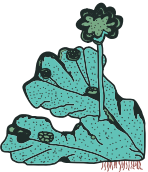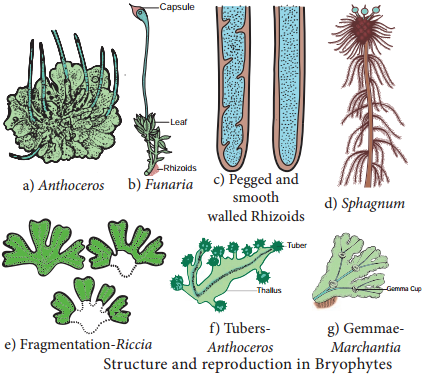Learninsta presents the core concepts of Biology with high-quality research papers and topical review articles.
Bryophytes Definition and its Economic Importance
Amphibians of Plant Kingdom
In the previous chapter, we noticed a wide range of thallus organization in Algae. Majority of them are aquatic. The development of heterotrichous habit, development of parenchyma tissue and dichotomous branching in some algae supports the view that colonization of plants in land occurred in the past.
Bryophytes are simplest and most primitive plant groups descended from alga – like ancestors. They are simple embryophytes. Let us learn about the structure and reproduction of these primitive land plants called Bryophytes in detail.

Bryophytes are simplest land inhabiting cryptogams and are restricted to moist, shady habitats. They lack vascular tissue and hence called ‘Non- vascular cryptogams’. They are also called as ‘amphibians of plant kingdom’ because they need water for completing their life cycle.
General Characteristic Features
- The plant body of bryophyte is gametophyte and is not differentiated into root, stem and leaf like structure.
- Most of them are primitive land dwellers. Some of them are aquatic (Riella, Ricciocarpus).
- The gametophyte is conspicuous, long lived phase of the life cycle. Thalloid forms are present in liverworts and Hornworts.
In Mosses leaf like, stem like structures are present. In Liverworts thallus grows prostrate on the ground and is attached to the substratum by means of rhizoids. Two types of rhizoids are present namely smooth walled and pegged or tuberculate.
Multicellular scales are also present. In Moss the plant body is erect with central axis bearing leaf like expansions. Multicellular rhizoids are present. The structure and reproduction in Bryophytes is given in Figure 2.5.

Vascular tissue like xylem and phloem are completely absent, hence called ‘Non vascular cryptogams’. Vegetative reproduction takes place by the formation of adventitious buds (Riccia fluitans) tubers develop in Anthoceros.
In some forms small detachable branches or brood bodies are formed, they help in vegetative reproduction as in Bryopteris fruticulosa. In Marchantia propagative organs called gemmae are formed and help in reproduction. Sexual reproduction is oogamous. Antheridia and Archegonia are produced in a protective covering and are multicellular.
The antheridia produces biflagellate antherozoids which swims in thin film of water and reach the archegonium and fuse with the egg to form diploid zygote.
Water is Essential for Fertilization
The zygote is the first cell of the sporophyte generation. It undergoes mitotic division to form multicellular undifferentiated embryo. The embryogeny is exoscopic (the first division of the zygote is transverse and the apex of the embryo develops from the outer cell). The embryo divides and give rise to sporophyte.
The sporophyte is dependent on gametophyte. It is differentiated into three recognizable parts namely foot, seta and capsule.
Foot is the basal portion and is embedded in the gametophyte through which water and nutrients are supplied for the sporophyte. The diploid spore mother cells found in the capsule region undergoes meiotic division and give rise to haploid spores. Bryophytes are homosporous. In some sporophytes elaters are present and help in dispersal of spores (Example: Marchantia). The spores germinate to produce gametophyte.
The zygote, embryo and the sporogonium constitute sporophytic phase. The green long living haploid phase is called gametophytic phase. The haploid gametophytic phase alternates with diploid sporophyte and shows heterologous alternation of generation. Proskauer in the year 1957 classified Bryophytes into 3 Classes namely:-
(i) Hepaticopsida:-
(Riccia, Marchantia, Porella and Riella)
(ii) Anthocerotopsida:-
(Anthoceros and Dendroceros)
(iii) Bryopsida:-
(Funaria, Polytrichum and Sphagnum).
Economic Importance
Dead thalli of Sphagnum gets accumulated and compressed, hardened to form peat. In northern Europe (Netherlands) peat is used as fuel in commercial scale. Apart from this nitrates, brown dye and tanning materials are derived from peat.
Sphagnum and peat are also used in horticulture as packing material because of their water holding capacity. Marchantia polymorpha is used to cure pulmonary tuberculosis. Sphagnum, Bryum and Polytrichum are used as food. Bryophytes play a major role in soil formation through succession and help in soil conservation.